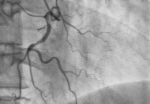Conventional transradial access (TRA) is already established as the access of choice for percutaneous coronary procedures, regardless of clinical presentation. This choice is based on multiple randomized studies and meta-analyses that have shown reduced bleeding at the puncture site, less vascular complications, and benefits on mortality (mainly in high-risk patients). The practicality of recovery allows...
Transfemoral vs Transradial Approach in the Percutaneous Treatment of CTO
Percutaneous treatment of chronic total occlusion (CTO) has traditionally been via the transfemoral approach (TFA). The use of the transradial approach (TRA) in complex coronary interventions has been increasing. A randomized study assessed the use of TRA vs TFA in complex PCI (58% CTO) and TRA saw favorable outcomes. The aim of this prospective, randomized,...
Fluoroscopy vs. Ultrasound Guided Femoral Access in TAVR
Ideally, we will not puncture the femoral artery blindly if we are planning to use a big caliber releasing device and a percutaneous closure device during TAVR. The risk of a high or low puncture or the presence of a lateral branch compromising the puncture site might become a major vascular and bleeding complication. There...
EuroPCR 2021 | COLOR: Complex PCI via Transradial vs Transfemoral Approach
Treating total occlusions, complex bifurcations, grossly calcified lesions or left main lesions via transradial approach is associated with significant reduction in access-site bleeding or vascular complications vs transfemoral approach. This kind of procedures have been typically excluded from studies randomizing patients to transradial vs transfemoral approach. The COLOR study used the transradial bore-guiding catheter Glidesheath...
[APT Medical Sponsored Clinical Case] Bilateral Distal Transradial Access for Chronic Total Occlusion Recanalization and Multivessel Coronary Disease Percutaneous Intervention
Introduction Chronic total occlusion (CTO) represents the most challenging setting for percutaneous coronary intervention (PCI) and multivessel coronary disease (MCD) is often treated in a staggered manner and in a deferred procedure. Although transfemoral is one of the common access site, the transradial access (TRA) has been used with similar procedural success [1]. The distal...
ProGlide vs. Prostar XL to Close Post-TAVR Access
Minimalist transcatheter aortic valve replacement (TAVR) is a strategy that is here to stay. We have previously published papers comparing local vs. general anesthesia, use of transthoracic vs. transesophageal echocardiography, and early discharge in TAVR. In all these papers, the “minimalist approach” included percutaneous closure of vascular access. However, few papers compare closure devices in...
TAVR: Should Transradial Approach be the Second Access Site?
Courtesy of Dr. Carlos Fava. One of the major challenges we interventional cardiologists still face is access management. Reduced device diameter and improved transcatheter closure, together with increased operator experience, have significantly reduced vascular complications. However, we shouldn’t lose sight of the secondary access, usually transfemoral, generally used in case of primary access site related...
Unilateral Vascular Access in TAVR: Our Main Procedure, Increasingly Minimalist
There has been a significant decline in vascular complications in the last few years due to improvements in device profiles and operator experience on transcatheter aortic valve replacement (TAVR). Unilateral vascular access for transfemoral TAVR is as safe as bilateral access and it could be more comfortable for patients according to this study recently published...
Subclavian and Axillary Access for TAVR: a Valid Alternative
Courtesy of Dr. Carlos Fava. The femoral approach is preferred when it comes to TAVR, but sometimes it is not viable. This is when other access sites come into play, such as the trans-subclavian/axillary (TS/TAx), the apical, transcaval, transcarotid (TC) or transaortic. At present, few studies have looked into this matter, which is why it...
Transcarotid Approach for Transfemoral in TAVR
Courtesy of Dr. Carlos Fava. At present, the transfemoral is the preferred access site in TAVR, for it has been shown to present fewer complications. However, whenever not feasible, we can resort to other approaches. These include the subclavian, the transapical, the transcaval, the transaortic, and the transcarotid. This last one has been studied few...









